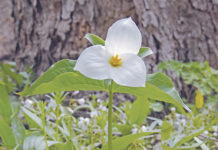Peaceful snow-covered scenery is what typically comes to mind when people hear “blanket of snow”. However, I studied cold damage to plants for many years, so I tend to think in more scientific terms. Snow is an excellent natural insulator because it creates air pockets between the snowflakes as it piles up. Four inches of snow can reduce the depth at which underlying soil freezes, but the deeper the snow is, the more insulating value it provides. Soil that is covered under twelve or more inches of snow can maintain a temperature at or near 32 F, even if the air temperature drops into the single digits. So, a blanket of snow is, in fact, keeping the plants and soil underneath warm in a way that protects them from cold temperatures and dry air.
Most of our region has seen little to no snow blanket this season, and some plants may have been damaged by the very low temperatures that we’ve seen in the past two weeks. Of our perennial forage crops, alfalfa is especially susceptible to damage from low temperatures, primarily due to frost heaves. Older, thinning stands of alfalfa are at a higher risk of frost heaving than younger, more productive stands. As moisture in the soil freezes, and the resulting ice expands and causes these heaves, large taproots in mature alfalfa can be pulled up with the soil. Frost heaves can also cause smaller, more fragile roots to shear off under the soil. Once the ground thaws, the alfalfa may not resettle, and this can leave an elevated crown above the soil surface.
The higher the crown is above the soil line in spring, the more overall damage will be observed. So it’s best to scout alfalfa stands in early spring to assess the overall damage.
Crowns that are elevated an inch or less above the soil line may regrow their roots, but they will have reduced productivity and are likely to experience further damage the following winter if not terminated. Crowns that are elevated more than an inch most likely experienced damage to the taproot, which will ultimately kill the plant. If the latter is the case for most of the field, you should consider terminating.
Frost heaving is more common when soils are saturated, have little residue and when there is little or no snow cover to help maintain higher soil temperatures. In Trumbull County, we had approximately 1.5 inches of rain in three days, which was followed by a week of very low temperatures. Our soil was saturated and the sudden temperature drop locked that moisture into our soil. The resulting frost heaves also locked up some barn doors — or at least it did for me.
Mitigating frost heaving
We don’t have the ability to control the weather, but there are several practices you can implement to reduce the risk of frost heaving. Two prevention strategies focus on increasing residue and minimizing bare soil.
• Don’t harvest late into the fall. The more residue and ground cover present when cold temperatures set in, the better insulated the ground will be. The recommended last date of harvest is Sept. 7 in northern Ohio and Sept. 14 in southern Ohio.
• Ensure your stand is healthy going into winter. Vigorous stands will have higher residue and be more resilient in the spring.
• Include grass species when planting, as the fibrous roots will also help protect the alfalfa and increase residue.
• Avoid wet fields. Saturated soil increases the risk of frost heaving, so it’s always better to plant in well-drained or tiled fields.
Grass forages typically don’t experience as much damage from frost heaving due to the fibrous growth of their roots, but they can still experience damage from prolonged freezing temperatures. Most of our species are relatively cold hardy, but you may still see some browning of the leaves about 7-10 days after temperatures get above freezing.
You can also take advantage of the frost heaving process to overseed clover into pasture or forage stands. The freeze-thaw cycle allows for clover seed to be pulled into the soil, which results in excellent seed-to-soil contact. The best time to do this in Ohio is mid-February into early March.














Great article,
Thank you